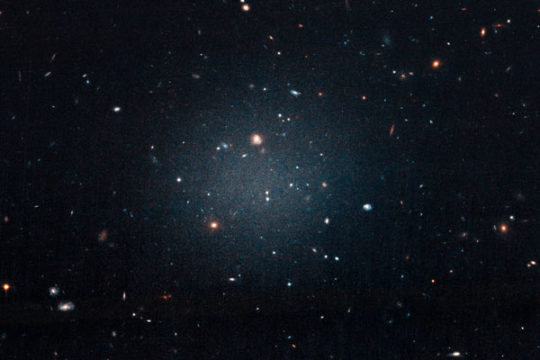
NASA / ESA / P. van Dokkum (Yale University)
It’s not a bug, it’s a feature.
The discovery of weird galaxies almost devoid of dark matter had astronomers worried that something might be wrong with their popular theories of the universe. But new supercomputer simulations reveal that such galaxies, although rare, are actually a natural outcome of the celebrated cosmological concordance model.
“We show that the standard paradigm naturally produces galaxies lacking dark matter,” writes a team led by Jorge Moreno (Pomona College) in today’s Nature Astronomy.
According to the successful ΛCDM model, the evolution of the universe is dominated by mysterious dark energy (denoted by the Greek capital lambda, Λ), and by equally puzzling cold dark matter (CDM). By this model, each and every glittering galaxy formed around an initial utterly invisible concentration of dark matter particles, vastly outweighing “normal” matter in the form of atoms.
So when the Dragonfly Telephoto Array in New Mexico hit upon two ultra-diffuse galaxies (DF2 and DF4), whose stellar motions hinted they had almost no dark matter at all, astronomers were stupefied. It was as if biologists had discovered a new mammal without a skeleton, contradicting evolutionary theory.
However, new numerical simulations based on the ΛCDM model do reproduce a number of galaxies with similar properties to DF2 and DF4. “We note that we did not expect this to occur a priori (that is, our simulation was not originally designed for this purpose),” the researchers write.
Moreno and his colleagues (including co-discoverer of DF2 and DF4, Shany Danieli of Princeton University) used a meticulous galaxy-identification technique to study the outcome of a cosmological simulation that mimics the evolution of the real universe. In a volume of some 350,000 cubic light-years, they identified seven small dark matter–deficient galaxies, which they named Bird, Blue, Deer, Long Hair, Paint, Wild Potato, and Wolf, after the seven clans of the Cherokee Native Americans. These galaxies also contain little gas.
All seven are located a few hundred thousand light-years from the cores of enveloping dark matter halos around much more massive central galaxies or galaxy groups. Wolf, in particular, is almost identical to DF2 and DF4 in terms of size, shape, stellar mass, dark matter content, and velocity distribution.
So how did these small galaxies lose most of their dark matter (and gas) while retaining their stars? The team speculates that multiple close passes by their host galaxies are to blame. The satellite galaxies probably started out much more massive, but while they lost “only” 45–97% of their stars and gas, tidal interactions robbed them of 97.9 to 99.99% of their dark matter.
Dark matter particles might be more susceptible to loss because they move on more eccentric orbits: they don’t interact through any other force than gravity, making it harder for the orbits to circularize over time. For this selective tidal stripping to happen, the satellite has to pass right through the stellar body of the host.
Interestingly, DF2 and DF4 are also close to a massive host galaxy, NGC 1052; however, astronomers can’t be sure whether they’ve experienced multiple close encounters in the past.

“It’s a very interesting result,” comments Tom Oosterloo (ASTRON Netherlands Institute for Radio Astronomy). There have been heated discussions about the discovery of dark matter–deficient galaxies and the implications for the ΛCDM model, he says, “but this paper shows that it is possible for them to exist, although they are apparently quite rare.”
Last December, Oosterloo and his colleagues announced the discovery of yet another dark matter–deficient ultra-diffuse galaxy, AGC 114905, which they observed in detail with the Very Large Array radio interferometer in New Mexico. However, that galaxy is different from DF2 and DF4: It’s isolated, and while it appears to be almost devoid of dark matter, it contains a substantial amount of gas.
Moreno and his colleagues are planning to study this kind of gas-rich, dark matter–poor galaxies in a future study. “I very much look forward to that,” says Oosterloo. “Also, I’d love to see a somewhat more quantitative analysis of their interaction scenario.”
Meanwhile, the team expects that more dark matter–poor satellite galaxies will be found in the future. Based on their simulations, they predict that a third of massive host galaxies — with a stellar mass of more than a hundred billion Suns, like the Milky Way — are accompanied by at least one dark matter–deficient satellite.
Advertisement
"lose" - Google News
February 15, 2022 at 01:23AM
https://ift.tt/f2htJin
How Galaxies Lose Their Dark Matter - Sky & Telescope - SkyandTelescope.com
"lose" - Google News
https://ift.tt/NzS6ud0 https://ift.tt/O9iD6Xe
Bagikan Berita Ini














0 Response to "How Galaxies Lose Their Dark Matter - Sky & Telescope - SkyandTelescope.com"
Post a Comment